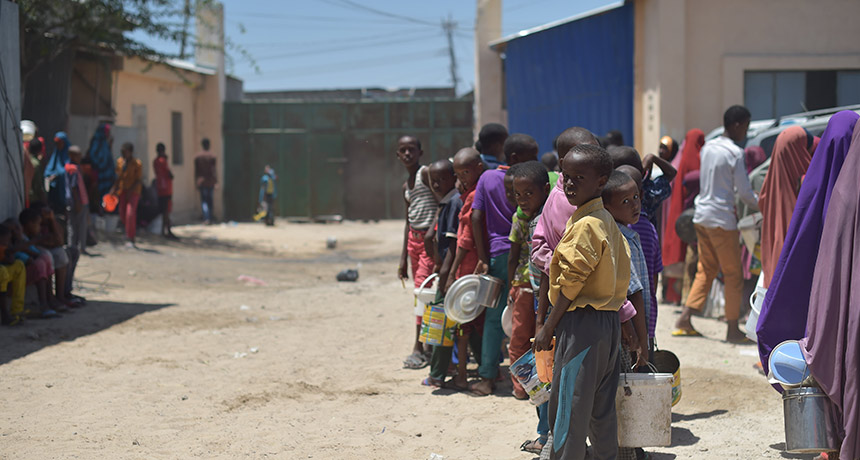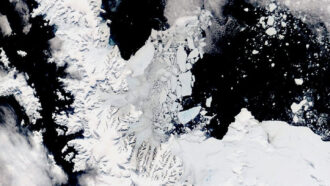Climate change greatly intensified many 2017 weather events
From droughts to deluges, scientists link 16 extreme events to global warming

Human-caused climate change was responsible for extremely warm ocean temperatures off the Horn of Africa from March through June 2017. That marine heat wave, researchers say, dramatically raised the chances of drought on land, such as the devastating one that led to food shortages in Somalia (shown).
AMISOM Public Information/Flickr
WASHINGTON, D.C. – A months-long heat wave scorched the Tasman Sea near New Zealand. Six straight days of rain flooded Bangladesh. Extreme summer drought parched Montana and the Dakotas. All of these extreme weather events happened in 2017. And all became more likely because of human-driven climate change, new studies find.
Each year since 2011, groups of scientists have studied links between climate and extreme weather events around the world. They hope to learn whether climate change is making such events more likely or more intense. And in most cases, the answer is yes, the scientists reported on December 10, 2018. Some of the researchers spoke that day at a news conference at the American Geophysical Union’s fall meeting. The full collection of studies also was published online the same day. It came out as a special issue of the Bulletin of the American Meteorological Society.
Climate change increased the likelihood of 16 extreme weather events in 2017, the studies found. For an intense outbreak of wildfires in Australia, it was unclear if climate played a role. But for the first time, none of the extreme events studied was found to be due to natural variations in climate.
And one of the events would not have happened at all without human-caused climate change, the scientists concluded. It’s only the second time such an event has been reported. The first was just last year. To the editors of the special issue, the latest findings reveal a new “normal” state of the world.
“Many events were found to have appreciable climate change input. That’s not itself a surprise,” Martin Hoerling reported at the news conference. A research meteorologist, he works for the U.S. National Oceanic and Atmospheric Administration in Boulder, Colo. He also served as an editor of the special issue. “We are in a world that is warmer than it was in the 20th century,” he said. “And we keep moving away from that baseline.”
In hot water
The Tasman Sea, between Australia and New Zealand, has heated up before. It’s seen several marine heat waves in the last decade. These include a severe one during the Southern Hemisphere summer of 2015–2016. But the 2017–2018 event was bigger. It warmed the entire sea. At its hottest, water temperatures rose at least 2 degrees Celsius (about 4 degrees Fahrenheit) above average. This warming devastated the region’s iconic kelp forests. It also helped drive record-breaking summer heat in New Zealand.
Climate change was responsible for another marine heat wave, a second study showed. That one hit off the coast of East Africa and lasted from March to June 2017. Without human-caused climate change it could not have happened, the researchers found.
Their study also showed the heat wave may have contributed to a harsh drought in East Africa. The rainfall shortfall led to food shortages for millions of people in the Horn of Africa. It affected 6 million in Somalia alone. The hot sea-surface temperatures, the researchers found, doubled the chances that such a drought would occur.
Another study looked at a six-day rainstorm that drenched Bangladesh in March 2017. Big storms are not uncommon during its rainy period, known as the monsoon season. Farmers rely on the monsoon season. They plant and plan their harvests around this period. But the 2017 monsoons hit unusually early. The flash flood it caused wiped out farm fields, notes study co-author Karsten Haustein.
Haustein is a climate scientist at the University of Oxford in England. He is part of a team that specializes in figuring out how climate change contributes to extreme weather events. It’s a research field known as attribution science. Climate change, the group found, dramatically upped the likelihood of such a severe storm hitting Bangladesh — by as much as 100 percent.
“Any given extreme event might occur, but the severity of the events, that’s really what has changed. And it’s going to continue to change,” says Haustein.
Legal liability
The new studies also push the science of climate-related extreme events into a new legal territory, argued Lindene Patton. She was speaking at the news conference. Patton works at the Earth & Water Law Group in Washington, D.C. There, she specializes in climate attribution.
Climate change didn’t get full blame for the events in most of the new studies. But it very likely helped cause — or intensified — nearly every extreme event examined. And that provides enough certainty to be legally important in a court of law, Patton said. “Perfection is not required,” she says. “You just need to know if it’s more likely than not.”
Legally, that opens the door to holding someone accountable for not taking action against the negative effects of climate-driven extremes in weather. That “someone” might be a person, a company or even a country. It isn’t yet clear how that blame might be assigned. Or what the consequences might be.
The threat of being held legally responsible may not be the best way to push more policies that will aid the environment, Patton noted. Still, she says, these threats have had some effect in the past. She described lawsuits in the 1970s against polluters. These suits helped lead to laws that now regulate pollutants.
Jeff Rosenfeld is the editor-in-chief of the journal that published the special issue. Some scientists, he notes, work on attribution studies of certain extreme events in real time. That is, while the event is still happening. One example: 2018’s Hurricane Florence. Such studies might make the special issue’s focus on events from a year earlier seem a bit late.
But he thinks the looming question of climate liability highlights why all such studies are important. The slower, more thorough approach sometimes provides more detail — and certainty.







